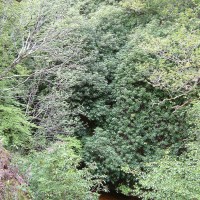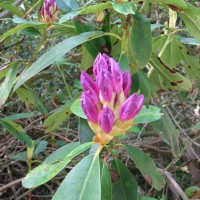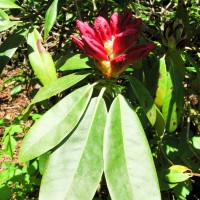
Rhododendron - Rhododendron ponticum
Expand and collapse the sections below by clicking on the title or + / - icons.
Short description of Rhododendron ponticum, Rhododendron
This evergreen shrub is densely branched growing to 5m. Flowers, borne in racemes of 10-15, are violet to purple. Pollination by insects results in the production of numerous small seeds within a woody capsule.
Impact summary: Rhododendron ponticum, Rhododendron
Its dense thickets shade out indigenous plants, preventing regeneration of trees in woods and obliterating the ground vegetation on moors. It is poisonous to livestock and cannot be controlled by grazing. It is host to the disease organisms Phytophthora ramorum and P. kernoviae, which attack oak and beech.
Habitat summary: Rhododendron ponticum, Rhododendron
Strictly confined to acid soils, its habitats include moorland, woods, screes, rocky banks, derelict gardens and streamsides. It is no longer extending its broad geographical range, and is being controlled at some sites but is still spreading at many others.
Overview table
| Environment | Terrestrial |
|---|---|
| Species status | Non-Native |
| Native range | Caucasus, Bulgaria, Spain, Lebanon, Portugal, Turkey |
| Functional type | Land plant |
| Status in England | Non-Native |
| Status in Scotland | Non-Native |
| Status in Wales | Non-Native |
| Location of first record | v.c.54 |
| Date of first record | 1894 |
Origin
British plants originate from the Iberian Peninsula, but have also been significantly introgressed by the American species Rhododendron catawbiense and R. maximum.
First Record
The first record from the wild was in 1894.
Pathway and Method
Introduced for ornamental horticulture, and subsequently planted both for its own merit and as a stock for grafting.
Species Status
Highly invasive in Ireland and well established in western France.
Dispersal Mechanisms
The small seeds are dispersed up to 100 m by wind and water under favourable open conditions, but often less far in closed canopy forest.
Reproduction
Flowers are pollinated by bees, hoverflies and butterflies. Each flower head can produce between three thousand and seven thousand seeds, so that a large bush can produce several million seeds per year. Seeds require light for germination. Stem layering occurs where there are mature bushes with limited support for their stems, especially at the edges of established stands.
Known Predators/Herbivores
Potentially toxic chemicals, particularly 'free' phenols, and diterpenes, occur in significant quantities in the tissues of rhododendron, such that foliage is unpalatable to vertebrates and few insects feed on the plant.
Resistant Stages
Seeds in the soil can remain viable for several years.
Habitat Occupied in GB
Moorland, woods, screes, rocky banks, derelict gardens and streamsides.
Native Range
A disjunct distribution. R. ponticum ssp. baeticum is found in south-west Spain and southern Portugal, whereas ssp. ponticum is found in Turkey, Lebanon, Bulgaria and the Caucasus.
Known Introduced Range
Naturalised in the United Kingdom, Ireland, Belgium, France and Netherlands. Present in Austria.
Trend
There is increasing invasion in continental Europe.
Environmental Impact
Once rhododendron has invaded an area, few native plants survive. In woodlands, only those trees which manage to grow above the level of the rhododendron canopy will persist. When such trees die, they cannot be replaced because seedlings cannot become established under the lightless canopy. At this point, the rhododendron completely dominates the area. Stands accumulate thick litter layers.
Health and Social Impact
Anecdotal information suggests that honey from rhododendron is toxic to humans. This is known as 'Honey intoxication' and results in relatively short-lived intestinal and cardiac problems but is rarely fatal. The severity of symptoms depends on the amount of contaminated honey consumed.
Economic Impact
It is a problem in commercial forests and it invades moorlands managed for gamebirds. A potentially major impact is its effect on oaks, beeches and nursery stock through the disease organisms Phytophthora ramorum and P. kernoviae, which are harboured by rhododendron.
Identification
Refer to the NNSIP identification guide
Biology, ecology, spread, vectors
Cross, J.R. (1975) Biological flora of the British Isles: Rhododendron ponticum. Journal of Ecology, 63, 345-364.
Milne, R.I., & Abbott, R.J. (2000) Origin and evolution of invasive naturalized material of Rhododendron ponticum L. in the British Isles. Molecular Ecology, 9, 541-556.
Stout, J.C., Parnell, J.A.N., Arroyo, J. & Crowe, T.P. (2006) Pollination ecology and seed production of Rhododendron ponticum in native and exotic habitats. Biodiversity and Conservation, 15, 755-777.
Management and impact
Dehnen-Schmutz, K., Perrings, C. & Williamson, M. (2006) Controlling Rhododendron ponticum in the British Isles: an economic analysis. Journal of Environmental Management, 70, 323–332.
General
https://www.cabi.org/isc/datasheet/47272
https://secure.fera.defra.gov.uk/nonnativespecies/downloadDocument.cfm?id=869
Spotted this species?
Distribution map
View the Distribution map for Rhododendron, Rhododendron ponticum from BSBI
Risk assessment
Risk assessment for Rhododendron ponticum. See a full list of non-native species Risk assessments.
Legislation
This species is listed under Schedule 9 of the Wildlife and Countryside Act 1981. Read more about Non-native species legislation.




















